Top speed 1,381 km/h Range 1,759 km | Wingspan 7.6 m Weight 3,250 kg | |
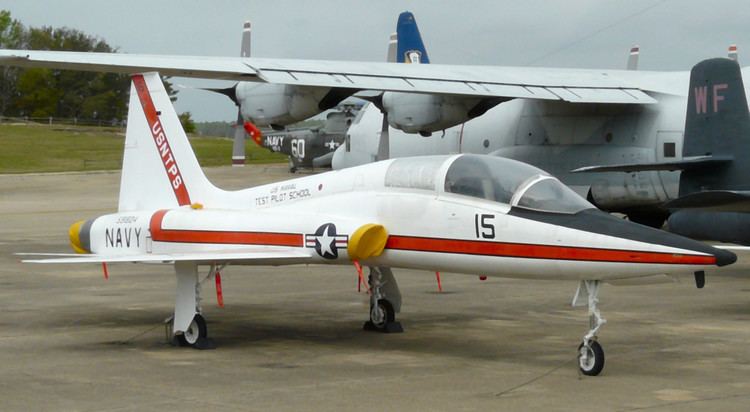 | ||
Unit cost 756,000–756,000 USD (1961) Engine types Turbojet, General Electric J85 | ||
The Northrop T-38 Talon is a two-seat, twin-engined supersonic jet trainer. It was the world's first supersonic trainer and is also the most produced. The T-38 remains in service as of 2017 in several air forces.
Contents
- Northrop t 38 talon high flight 1972 educational
- Design and development
- Military
- NASA
- Accidents
- Replacement
- Civil
- Variants
- Operators
- Former operators
- Aircraft on display
- Specifications T 38A
- References
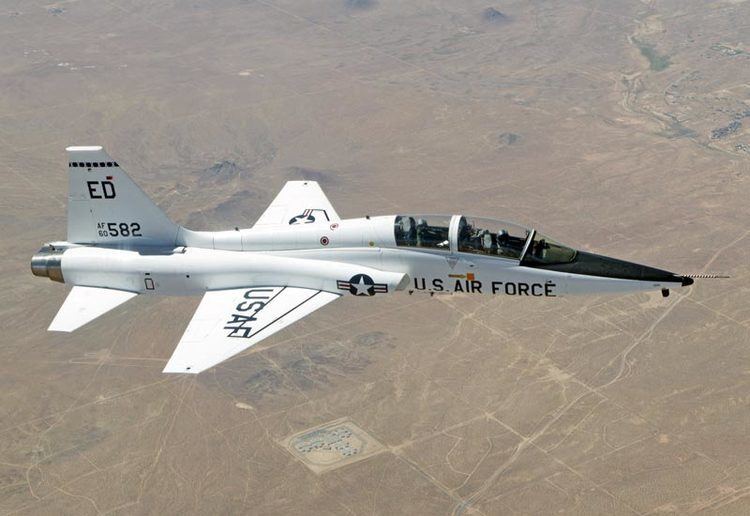
The United States Air Force (USAF) operates the most T-38s. In addition to training USAF pilots, the T-38 is used by NASA. The U.S. Naval Test Pilot School is the principal US Navy operator (other T-38s were previously used as USN aggressor aircraft until replaced by the similar Northrop F-5 Tiger II). Pilots of other NATO nations fly the T-38 in joint training programs with USAF pilots.
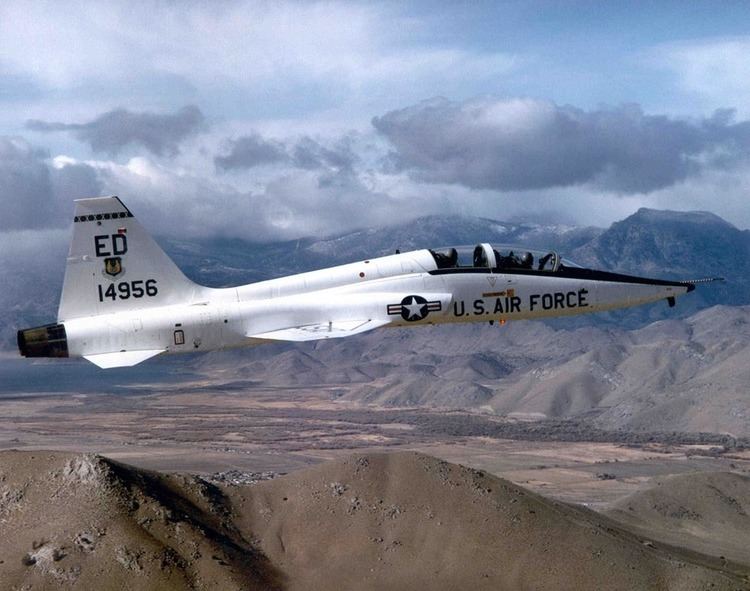
As of 2015, the T-38 has been in service for over 50 years with its original operator, the United States Air Force.
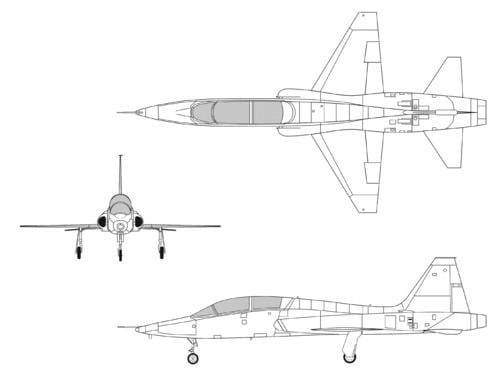
Northrop t 38 talon high flight 1972 educational
Design and development
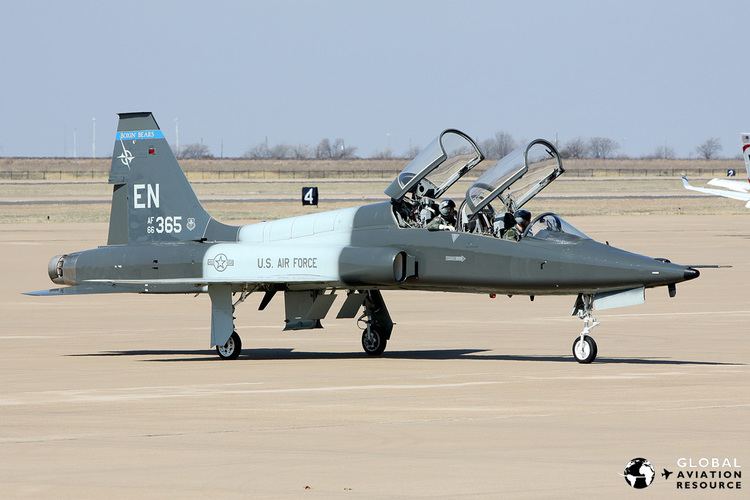
In 1952 Northrop began work on a fighter project, the Fang, with shoulder-mounted delta wing and a single engine. The proposed General Electric J79 engine, weighing nearly two tons, meant the resulting aircraft would be large and expensive. Then in 1953, representatives from General Electric Aviation's newly created Small Aircraft Engine Department showed Northrop a relatively tiny engine (around 400 lb installed wt) capable of 2,500 lb of thrust, and Northrop VP-Engineering Edgar Schmued saw the possibility of reversing the trend toward the large fighters. Schmued and chief engineer Welko Gasich decided on a small twin-engine "hot-rod" fighter, the N-156. Northrop began its N-156 project in 1954, aiming for a small supersonic fighter jet capable of operating from the US Navy's escort carriers. However, when the Navy chose not to pursue equipping its fleets in that fashion, Northrop continued the N-156 design using in-house funding, recasting it as a lightweight fighter (dubbed N-156F) and aimed at the export market.
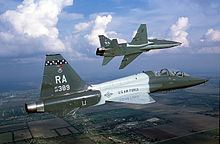
In the mid-1950s the USAF issued a General Operating Requirement for a supersonic trainer, planning to retire its 1940s-era Lockheed T-33s. Northrop officials decided to adapt the N-156 to this competition. The only other candidate was the two-seat version of the North American F-100 Super Sabre. Although the F-100 was not considered the ideal candidate for a training aircraft (it is not capable of recovering from a spin), NAA was still considered the favorite in the competition due to that company's favored-contractor status with the Air Force. However, Northrop officials convincingly presented life-cycle cost comparisons which could not be ignored, and they were awarded the contract, receiving an order for three prototypes. The first (designated YT-38) flew on 10 March 1959. The type was quickly adopted and the first production examples were delivered in 1961, officially entering service on 17 March that year, complementing the T-37 primary jet trainer. When production ended in 1972, 1,187 T-38s had been built (plus two N-156T prototypes). Since its introduction, it is estimated that some 50,000 military pilots have trained on this aircraft. The USAF remains one of the few armed flying forces using dedicated supersonic final trainers, as most, such as the US Navy, use high subsonic trainers.
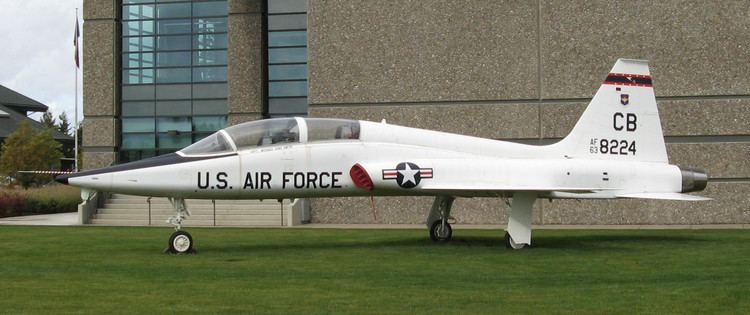
The T-38 is of conventional configuration, with a small, low, long-chord wing, a single vertical stabilizer, and tricycle undercarriage. The aircraft seats a student pilot and instructor in tandem, and has intakes for its two turbojet engines at the wing roots. Its nimble performance has earned it the nickname white rocket. In 1962 the T-38 set absolute time-to-climb records for 3,000, 6,000, 9,000 and 12,000 meters, beating the records for those altitudes set by the F-104 in December 1958. (The F-4 beat the T-38's records less than a month later.)
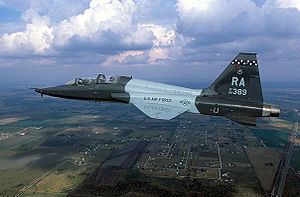
The F-5B and F (which also derive from the N-156) can be distinguished from the T-38 by the wings; the wing of the T-38 meets the fuselage straight and ends square, while the F-5 has leading edge extensions near the wing roots and wingtip launch rails for air-to-air missiles. The wings of both the T-38 and the F-5 family use conventional skin over spar-rib structure.
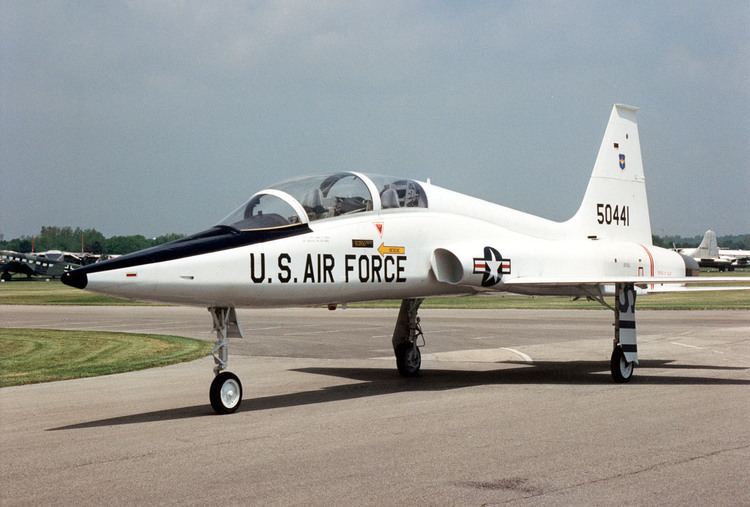
Most T-38s built were of the T-38A variant, but the USAF also had a small number of aircraft converted for weapons training (designated AT-38B), which were fitted with a gunsight and could carry a gunpod, rockets, or bombs on a centerline pylon. In 2015, 504 T-38s were still operational with the USAF, with many more in operation around the world. Most of the USAF variant aircraft (T-38A and AT-38B) have been converted to the T-38C through an avionics upgrade program. Improvements include the addition of a HUD, GPS, INS (Inertial Navigation System), and TCAS. Most jets have also received PMP (a propulsion modification to improve low-altitude engine thrust). Approximately a third of the fleet (those that experience more severe usage) are currently undergoing structural replacements and upgrades, as well as receiving new wings, to extend their service life to 2029.
The fighter version of the N-156 was eventually selected for the US Military Assistance Program and produced as the F-5 Freedom Fighter. Many of these have since reverted to a weapons training role as various air forces have introduced newer types into service. The F-5G was an advanced single-engined variant later renamed the F-20 Tigershark.
Military
The USAF Strategic Air Command (SAC) had T-38s in service from 1978 until SAC's 1991 inactivation. These aircraft were used to enhance the career development of bomber copilots through the "Accelerated Copilot Enrichment Program." They were later used as proficiency aircraft for all B-52, B-1, Lockheed SR-71, U-2, Boeing KC-135, and KC-10 pilots. SAC's successors, the Air Combat Command (ACC) and the Air Force Global Strike Command (AFGSC), continue to retain T-38s as proficiency aircraft for U-2 pilots and B-2 pilots, respectively.
The Air Training Command's (ATC) successor, the Air Education and Training Command (AETC), uses the T-38C to prepare pilots for the F-15C Eagle and F-15E Strike Eagle, the F-16 Fighting Falcon, B-52 Stratofortress, B-1B Lancer, B-2 Spirit, A-10 Thunderbolt, F-22 Raptor and F-35 Lightning II. The AETC received T-38Cs in 2001 as part of the Avionics Upgrade Program. The T-38Cs owned by the AETC have undergone propulsion modernization which replaces major engine components to enhance reliability and maintainability, and an engine inlet/injector modification to increase available takeoff thrust. These upgrades and modifications, with the Pacer Classic program, should extend the service life of T-38s past 2020. The T-38 has an availability goal of 75% which it maintained in 2011, however in 2015 availability is 60%.
Besides the USAF, USN and NASA, other T-38 operators included the German Air Force (Luftwaffe), the Portuguese Air Force, the Republic of China Air Force, and the Turkish Air Force.
NASA
NASA operates a fleet of thirty-two T-38 aircraft and uses the aircraft as a jet trainer for its astronauts, as well as a chase plane. Its fleet is housed primarily at Ellington Field in Houston, Texas. NASA's internal projections show the number of operational jet trainers falling to 16 by 2015. The agency spends $25–30 million annually to fly and maintain the T-38s.
During the Space Shuttle era it was established NASA tradition for astronauts to arrive at the Kennedy Space Center in T-38 Talons.
Accidents
More than 210 aircraft losses and ejections have been documented over the lifetime of the T-38.
NASA's T-38s were involved in four separate fatal accidents in the 1960s and 1970s, and several non-fatal incidents.
In response to the 1973 OPEC oil embargo, from 1974 to 1983, the U.S. Air Force Thunderbirds aerobatic display team adopted the T-38 Talon, which used far less fuel than the F-4 Phantom. The Blue Angels downsized to the Douglas A-4 Skyhawk at roughly the same time. After the infamous 1982 "Diamond Crash" incident that killed four of the Thunderbirds' six demonstration pilots, the T-38 was replaced in this role by the front line F-16A Fighting Falcon.
Two fatal crashes in 2008, on 23 April at Columbus Air Force Base in Mississippi and on 1 May at Sheppard Air Force Base in Wichita Falls, Texas, resulted in four fatalities, causing the Air Force to temporarily ground the aircraft. On 21 May 2009, a T-38 crashed just north of Edwards Air Force Base in the Mojave Desert.
Replacement
The USAF has launched the T-X Program, to replace the T-38. Aviation Week & Space Technology reporters wrote in 2010 "there appears to be no rush to purchase T-38 replacements"; "the service is conducting an analysis of alternatives" with results "not expected to be ready until the Fiscal 2013 budget". In subsequent years, the Air Force indicated it would launch a competition for the T-38's replacement. Likely bidders include: A partnership of BAE Systems and Rolls Royce, offering the Hawk trainer, equipped with Rolls' Adour Mk951 engine offering 6,500 lb of thrust and FADEC; Lockheed Martin and Korea Aerospace Industries, offering the T-50; and Raytheon and Alenia Aermacchi offering the T-100, an aircraft whose design originated with the M-346.
Civil
There are seven privately owned T-38s in the U.S. Boeing owns two T-38s, which it uses as chase planes. Thornton Corporation owns two T-38s and three F-5s and the National Test Pilot School owns one T-38. In addition, ILOAJP HOLDING and Wayne L. Siltanen own one each.
Variants
Operators
United States Air Force has 508 T-38 trainers in service as of September 2012.
Air Combat CommandUnited States Navy has ten aircraft in use as November 2008.
Naval Air Warfare Center Aircraft DivisionNASA has approximately 32 aircraft bailed from USAF.
Former operators
Aircraft on display
Specifications (T-38A)
Data from USAF factsheet
General characteristics
Performance
